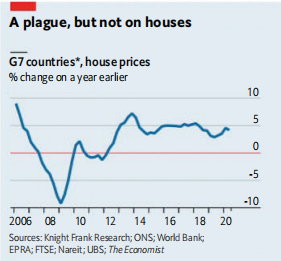- 阅读
- 阅读
- 技巧
- 百科
- 试题
- 文化
- 技能
Finance & economics
财经
Global housing markets
全球房地产市场
The three pillars
三大支柱
Why, despite the coronavirus pandemic, house prices continue to rise.
新冠当下,房价为何还在涨?
During the global recession a decade ago, real house prices fell by an average of 10%, wiping trillions of dollars off the world's largest asset class. Though the housing market has not been the trigger of economic woes this time, investors and homeowners still braced for the worst as it became clear that covid-19 would push the world economy into its deepest downturn since the Depression of the 1930s.
十年前的全球衰退导致房价平均下跌了10%,世界最大的资产类别损失了数万亿美元。显然,新冠肺炎将把世界经济推入自上世纪30年代大萧条以来最严重的衰退。尽管这一次房地产市场并非经济危机的导火索,但投资者和房主已然做好了最坏的打算。
That pessimism now looks misplaced. House prices picked up in most middle and-high-income countries in the second quarter. In the rich world they rose at an annual rate of 5%. Share prices of developers and property-traders fell by a quarter in the early phase of the pandemic, but have recovered much of the fall.
现在看来,这种悲观情绪似乎不合时宜。大多数中高收入国家的房价在第二季度已经有所回升,发达国家的房价则以每年5%的速度在增长。疫情初期,开发商和房地产商的股价下跌了四分之一,但目前已经收复了大部分失地。

Some markets are fizzing. In August house prices in Germany were 11% higher than the year before; rapid growth in South Korea and parts of China has prompted the authorities to tighten restrictions on buyers. In America growth in the median price per square foot accelerated more quickly in the second quarter of 2020 than in any three-month period in the lead-up to the financial crisis of 2007-09. Three factors explain this strength: monetary policy, fiscal policy and buyers' changing preferences.
一些市场正在沸腾。8月德国的房价较去年增加了11%。韩国和中国部分地区房价涨势迅猛,政府不得不收紧对购房者的限制。美国2020年第二季度每平方英尺中值价格的增长速度比2007-09年金融危机前的任何一个季度都要快。可以解释这一优势的因素有三点:货币政策、财政政策和购房者偏好的变化。
Consider monetary policy first. Central bankers around the world have cut policy rates by two percentage points on average this year, reducing the cost of mortgage borrowing. Americans can take out a 30-year fixed-rate mortgage at an annual interest rate of just 2.9%, down from 3.7% at the beginning of the year. Studies suggest a strong link between falling real interest rates and higher house prices. Some borrowers can afford to take out bigger mortgages; others find it easier to manage their existing loans. Landlords are willing to pay more for property, because yields on other assets have dropped. In both America and Britain, mortgage lending is running at post-financial-crisis highs.
首先是货币政策。今年,世界各国央行将政策利率平均下调了2个百分点,降低了抵押贷款的成本。美国人可以以每年2.9%的利率获得30年期固定利率抵押贷款,比年初下降了0.8%。研究表明,实际利率的下降与房价上涨之间存在联系密切。一些借款人能够承担更大的抵押贷款,而其他借款人则发现管理现有贷款变得更加容易。房东愿意为房产支付更多的钱,因为其他资产的收益已经下降。在美国和英国,抵押贷款都处在金融危机后的最高水平。
That is not to say that it has become easier for everyone to borrow. In fact, obtaining a mortgage has become harder for many. Brokers, fearful of the long-term economic impact of covid-19, have pulled back on riskier lending. British banks, for instance, are offering fewer high-loan-to-income mortgages. In America few loan officers at banks said they were tightening lending standards before the pandemic; now 60% do. In contrast with previous periods of strong house-price growth, there is little evidence of lax lending standards.
这并不是说贷款对每个人来说都变得更加容易,实际上有很多人越来越难获得贷款。因为担心新冠会给经济带来长期影响,经纪公司已经撤回了高风险贷款。例如,英国的银行正在减少提供高贷款收入比的抵押贷款。在美国,疫情爆发前银行很少有信贷员说他们在收紧贷款标准,而现在有60%的信贷员这么说。与之前房价暴涨的时期相比,贷款标准显有松懈迹象。
来源:可可英语
参与评论